



US Feed Outlook
US feed grain supplies are expected to be up slightly from last month, but they show a fall year on year, according to the USDA Economic Research Service Feed Outlook for January 2009. Production of corn and Sorghum is up, and ever more corn being used to produce ethanol, the report says.Corn Ending Stocks Up 316 Million Bushels This Month
Domestic changes this month are based in part on USDA’s National Agricultural Statistics Service's Crop Production 2008 Summary and January Grain Stocks reports. Total 2008/09 feed grain production increased due to larger corn and sorghum crops. Total feed grain utilization decreased from 329.8 million tons to 323.3 million tons because of decreased feed and residual use, exports, and food, seed and industrial use. Projected global coarse grain ending stocks are up 12.8 million tons this month to 178.4 million. US feed grain ending stocks are projected 21 percent higher this month, and forecast season average prices are lower for corn and sorghum. Hay supplies per roughage-consuming animal unit (RCAU) are up from last year, as is silage production per RCAU.
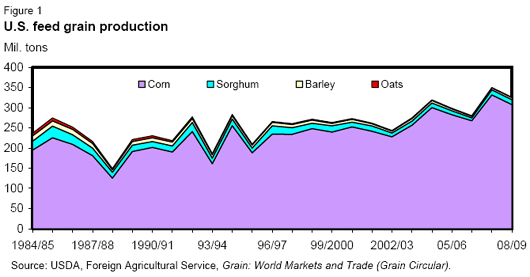
Feed Grains Supplies Up in 2008/09
Feed grain supplies for 2008/09 are forecast at 373.9 million metric tons, up slightly from last month but down 4 per cent from last year. The 2008 corn and sorghum crop are up month-to-month, but barley and oats production is unchanged. Beginning stocks remain unchanged this month.
Total feed grain use is projected 6.5 million tons lower at 323.3 million this month. Domestic use of the four feed grains is lowered 5.2 million tons this month. This drop is the result of lower projections for feed and residual use and food, seed and industrial use (FSI), including ethanol. Feed grain exports for 2008/09 are projected down 1.3 million tons. The decrease in domestic use and exports results in ending stocks being increased 8.8 million tons to 50.6 million. In 2007/08, ending stocks for the four feed grains totaled 45.1 million tons.
Feed and residual use for the four feed grains plus wheat converted to a September-August marketing year is down 2.52 million tons this month because of decreases in projected corn and sorghum feeding. Grain-consuming animal units are down slightly to 92.96 million, down from 92.98 million last month, due to lowered pork and broiler production forecasts in 2009. Feed and residual use per animal unit remained unchanged at 1.60 tons.
Small supply and use changes for feed grains in 2007/08 and earlier years are made based on revisions in Field Crops Final Estimates 2002-2007. A 36-million-bushel reduction in 2007/08 corn production and an offsetting reduction in feed and residual use are the most significant changes. The changes can be found on the yearbook tables of the Feed Grains database by clicking here.


Corn Use Prospects Decrease in 2008/09
Corn production for 2008/09 is increased 81 million bushels this month to 12,101 million bushels. This month’s increase is a result of a 93,000-acre increase in planted area and a 463,000-acre increase in harvested area. Yield is increased from 153.8 bushels per acre to 153.9 bushels per acre. Beginning stocks remain unchanged from last month.
As a result of reduced demand, domestic use is decreased 185 million bushels this month to 10,200 million, down from 10,302 million bushels last year. Projected feed and residual use is lowered 50 million bushels to 5,300 million, reflecting lower livestock feeding and lower September-November disappearance as indicated by December 1 stocks. FSI use is lowered 35 million bushels, with corn used for sweeteners and starch in the first quarter being weaker than expected due to unfavorable economic conditions. Corn used to make high-fructose corn syrup (HFCS) in September-November 2008 was 110 million bushels, down from 120 million bushels during the same months in 2007. While the September-November period is not the usual high point in seasonal usage, the lower use does suggest less HFCS corn use for the year. Corn used for glucose and dextrose during September- November was higher than last year so projected annual use was raised. In September-November, corn used for starch production was down 5.8 million bushels from the same period last year, suggesting lower use for the year.
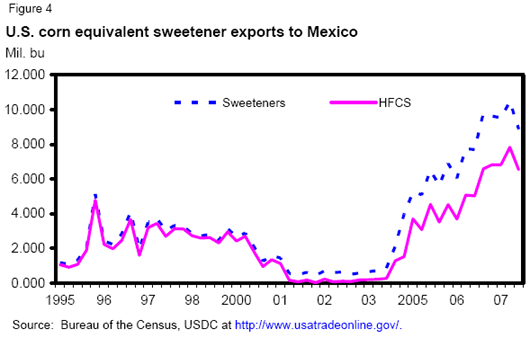

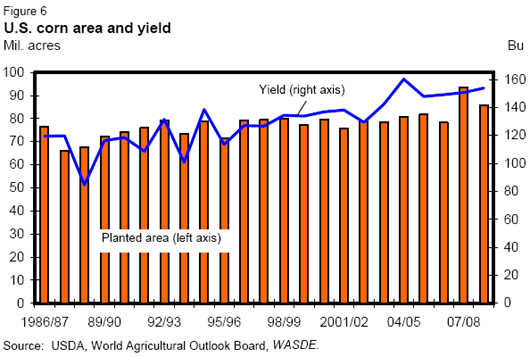

Corn used for fuel alcohol production in September-November 2008 is projected at 900 million bushels, up from 644 million bushels in the same period a year ago. Projected 2008/09 corn use for ethanol is decreased 100 million bushels this month to 3,600 million. Sustained negative ethanol production margins since early December have reduced incentives for ethanol output. Ethanol prices are currently above conventional gasoline prices which increases demand for Renewable Identification Numbers (RINs) as an alternative way to meet mandated biofuel requirements. The traded value of RINs have increased sharply in recent weeks.
The Renewable Fuel Standard (RFS) mandated a system for tracking renewable fuels by assigning RINs. Each RIN is a 38-digit number unique to each producer or importer and each gallon of renewable fuel, which allows the Environmental Protection Agency (EPA) to track production, movement, and use of renewable fuels to meet RFS mandated levels. As ethanol is produced or imported, the producer or importer has the responsibility to assign this series of numbers to its product. Once the RIN is assigned to the fuel, this number can be used as a credit toward the RFS mandate. Blenders and other obligated parties must generate an assigned minimum quantity of biofuel RINs each year (derived as a specific percentage of their total gasoline of diesel fuel sold or introduced into commerce) to remain compliant with the mandated biofuel use levels of the RFS. If a blender blends more renewable fuel than is required, that blender generates excess RINs. These excess RINs can be traded or sold to another blender that finds it more economical to purchase RINs instead of blending ethanol or biodiesel.
To find more information about the RFS and RINs, click here.
Exports are lowered 50 million bushels this month to 1,750 million due to the slow pace of sales and shipments to date. Total corn use for 2008/09 is projected down 235 million bushels, which is down 787 million from last year. Corn ending stocks for 2008/09 are expected to be 1,790 million bushels, up 316 million bushels from last month due to reduced use. With increased ending stocks, the 2008/09 season average farm price projection is lowered 10 cents on both ends of the range to $3.55 to $4.25 per bushel.
Changes are made to the 2007/08 corn supply and use tables. Corn yield estimates for 2007/08 are lowered 0.4 bushels per acre this month to 150.7 bushels per acre. Production is decreased 36 million bushels to 12,101 million bushels resulting in an offsetting decrease in feed and residual use now at 5,938 million bushels. FSI use is lowered 1 million bushels this month to 4,363 million bushels on lower estimated seed use. Ending stocks for 2007/08 remain unchanged.
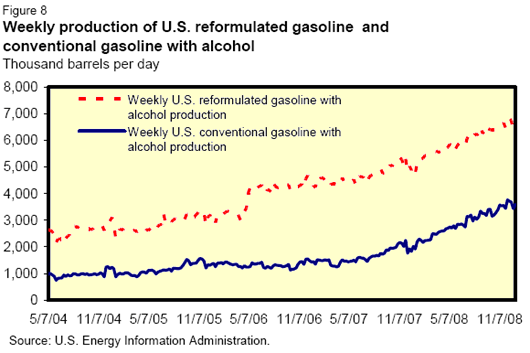
Sorghum Production Increases in 2008/09
Sorghum production for 2008/09 is estimated at 472 million bushels, up 7 million bushels from last month but 5 percent below 2007/08. The upward revision to this year’s production is based on increased yields. Average sorghum yield, at 65.0 bushels per acre, is up 2.0 bushels from the previous month but down 8.2 bushels from last year. Planted area is estimated at 8.3 million acres, down just 43,000 acres from last month but up 7 percent from last year. Area harvested for grain, at 7.3 million acres, is down 114,000 acres from last month but up from 6.8 million acres in 2007/08.
Forecast sorghum feed and residual use for 2008/09 is decreased 20 million bushels this month. At 230 million bushels, this year’s feed and residual use is up from 164 million bushels last year. With larger supplies, sorghum ending stocks for 2008/09 are projected 27 million bushels higher than last month at 95 million, up from 53 million in 2007/08. With the increase in expected supplies and ending stocks, the season average farm price is projected 10 cents lower on both ends of the range to $2.90 to $3.50 per bushel.
Small changes are made to the 2007/08 sorghum supply and use tables. Sorghum yield in 2007/08 is lowered 1 bushel per acre to 73.2 bushels per acre. Production is lowered 8 million bushels to 497 million. The production change resulted in lower feed and residual use, down 8 million bushels, to 164 million. This results in total use of 477 million bushels, down from 484 million last month. Ending stocks for 2007/08 remain unchanged.
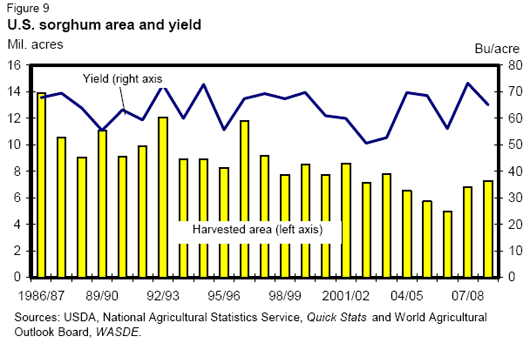

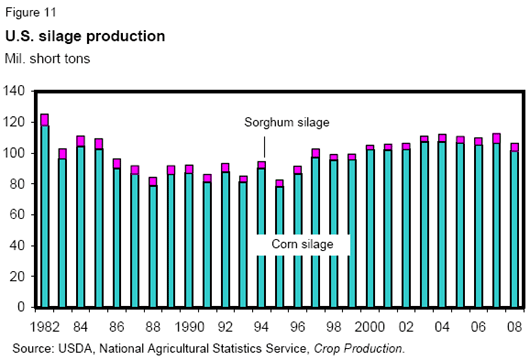
Barley Prices Forecast To Decrease in 2008/09
Supply and use estimates for barley in 2008/09 are unchanged this month. Forecast barley prices received by farmers are increased 10 cents on the low end of the range and decreased 10 cents on the upper end of the range this month to $4.95 to $5.35 per bushel.
Minor changes are made to the 2007/08 supply and use estimates. Estimated yield for 2007/08 is decreased 0.4 bushels per acre to 60.0 bushels per acre. Barley production is lowered 2 million bushels to 210 million. The production change resultes in lower feed and residual use, down 2 million bushels to 32 million. FSI use is decreased 1 million bushels on lower seed use. This results in total use of 242 million bushels, down from 244 million last month. Ending stocks for 2007/08 remain unchanged.
Oats Prices Down in 2008/09
Supply and use estimates for oats in 2008/09 are unchanged this month. Forecast oats prices received by farmers are increased 10 cents on each end of the range this month to $2.90 to $3.10 per bushel.
Minor changes are made to the 2007/08 supply and use estimates. Estimated yield for oats is decreased 0.9 bushels per acre to 60.1 bushels per acre. Oats production is lowered 2 million bushels per acre this month to 90 million bushels. Feed and residual use and FSI use are both lowered 1 million bushels this month in line with the decrease in supply. Ending stocks for 2007/08 remain unchanged.
Hay Supplies Decrease in 2008/09
Stocks of all hay stored on farms totaled 104 million tons on December 1, 2008, down less than 1 percent from a year ago. Disappearance of hay from May- December 2008 totaled 63.6 million tons, compared with 57.8 million tons for the same period a year ago. Compared with stocks on December 1, 2007, hay stocks increased in most areas east of the Mississippi and portions of the Southwest. The growing conditions were favorable in the South in 2008 in contrast to the extreme drought conditions that prevailed in the region in 2007.
Roughage consuming animal units (RCAU) in 2008/09 are estimated at 72.38 million, down slightly from 72.27 million in 2007/08. Hay stocks are 1.43 tons per RCAU, down from 1.44 tons last year.
Hay production totaled 146 million tons, down 3 percent from the October 1 forecast and down 1 percent from the previous year. Area harvested, at 60.1 million acres, is down 1 percent from the October forecast and down 2 percent from 2007. The average yield, at 2.43 tons per acre, is down 0.06 tons from October but up 0.02 tons from the previous year.
Production of alfalfa and alfalfa mixtures is estimated at 69.6 million tons, down 3 percent from the October 1 forecast and down slightly from 2007. Harvested area, at 21.0 million acres, is 1 percent above the October forecast but 1 percent below the previous year. The average yield is 3.32 tons per acre, 0.12 tons below the previous forecast but 0.01 tons above 2007. Other hay production totaled 76.1 million tons, down 4 percent from the October 1 forecast and down 1 percent from 2007. Area for harvest, at 39.1 million acres, is down 1 percent from October and 2 percent below last year.

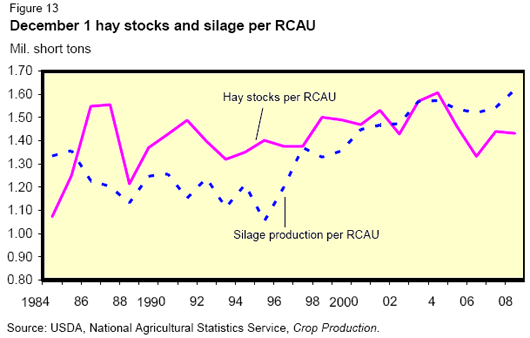
Corn silage production is estimated at 112 million tons in 2008, up 5 percent from 2007. The corn silage yield is estimated at 18.7 tons per acre, up 1.2 tons from last year while area harvested for silage, at 5.97 million acres, is down 2 percent from a year ago. Sorghum silage production in 2008 totaled 5.65 million tons, up 8 percent from 2007. Area harvested is up 4 percent from 2007 to 408,000 acres. Sorghum silage yields averaged 13.8 tons per acre, up 0.4 tons per acre from 2007. Total silage per RCAU in 2008/09 was 1.62 tons, up from 1.54 tons in 2007/08.
In the first 8 months of the hay marketing year (May-April), hay prices have averaged 24 percent higher in 2008 than in 2007. Alfalfa hay prices averaged $35.38 per ton above prices a year earlier during May through December. Other hay prices averaged $14.63 per ton above prices a year earlier during May through December.
World Coarse Grain Production Up This Month
World coarse grain production for 2008/09 is projected up 5.0 million tons this month to 1,102.4 million tons, mostly on higher corn output. Higher estimated U.S. corn production and a large upward revision to China’s corn production more than offset reduced corn production for Brazil and Argentina. Global sorghum production is raised slightly on revised U.S. output. World barley production is reduced slightly as a 0.4-million-ton reduction for Turkey more than offsets an increase for France. World mixed grain production is lowered slightly on a decrease for France.
China’s 2008/09 corn crop is revised up 5.5 million tons this month to 165.5 million based on reports from China supported by other information. Weather data on temperatures and precipitation, satellite imagery, and anecdotal observation by crop experts all point to a dramatic improvement in corn yields in 2008, compared to those the previous year. The implied record yield of 5.6 tons per hectare is 9 percent higher than that of the previous year when severe dryness in parts of major growing areas in Manchuria limited production.
Brazil’s 2008/09 corn production prospects are reduced 2.0 million tons this month to 51.5 million. Several weeks of hot, dry weather in the largest corn producing state, Parana, happened to hit right during corn reproduction. The soils are generally light and well drained, so previous above-normal rainfall did not prevent yield loses. DERAL, the state ministry of agriculture, quantified the damage in Parana, and dryness extended into nearby states.
Argentina’s 2008/09 corn production prospects are down 1.5 million tons to 16.5 million tons. Hot temperatures and dryness have persisted across important corn growing areas of Santa Fe, Entre Rios, and parts of Buenos Aires province. The damage to corn entering reproduction has more than offset favorable rains further west in parts of Cordoba and La Pampa. Yield prospects are reduced, and harvested area is slightly lower as more area may be cut for silage or abandoned. The strengthening “La Nina” in the Pacific is often associated with below normal rainfall across Argentina and parts of Southern Brazil.
Mexico’s corn production is revised up 1.0 million tons to a record 25.0 million. Favorable rainfall across the main corn growing region in Mexico’s Central Plateau has boosted yield prospects to 3.36 tons per hectare, up 9 percent from the previous year’s record. High corn prices during the spring and summer of 2008 likely encouraged optimal input use.
Zimbabwe’s corn production forecast for 2008/09 is slashed 0.53 million tons to 0.32 million. Both area and yield are cut by 38 percent due to severe economic and political problems. Rainfall has not been particularly poor.
In Russia and France, late harvest reports boosted corn production 0.3 million tons each. Turkey also reported slightly higher corn production. However, France’s mixed grain output was revised down slightly.

Global beginning stocks of coarse grains for 2008/09 are slightly higher this month, mostly due to a 0.4-million-ton increase for Turkey, based on a reduced estimate of 2007/08 corn use.
Global Recession Trims 2008/09 Consumption Prospects
Coarse grain imports and consumption projected for 2008/09 are reduced for a number of countries this month as the sluggish economy is limiting demand. World coarse grain use is down 7.4 million tons to 1,080.1 million. Foreign coarse grain consumption is down 2.2 million tons to 804.7 million, with foreign corn use down 2.0 million to 524.1 million. Turkey’s barley consumption is down 0.5 million tons due to reduced production, but Mexico’s sorghum use is up 0.3 million.
Egypt’s corn imports, consumption, and feed use prospects for 2008/09 are each cut 0.3 million tons. Consumption and corn feed use is trimmed 0.2 million tons each for Guatemala, Colombia, Syria, Saudi Arabia, Taiwan, and Algeria. There were smaller reductions for Malaysia and Bosnia. Generally weak economic growth is expected to limit incomes and demand for meat. Reduced corn production is expected to cut corn food use prospects for Zimbabwe and North Korea, countries with a portion of the population having nutritional problems. However, corn consumption in India is projected up 0.6 million tons as export prospects are slashed due to high internal prices. With increased corn production and beginning stocks, Turkey’s corn use is projected slightly higher.
Global Ending Stocks Prospects Boosted
Increased global production and reduced use expected in 2008/09 are combining to increase projected ending stocks. Global 2008/09 coarse grain ending stocks are projected up 12.9 million tons this month to 178.4 million. Nearly all of the change is for corn, with barley stocks up slightly and sorghum stocks reduced slightly.
After the 8.7-million-ton increase in U.S. coarse grain stocks, the dominant increase in ending stocks prospects is for China corn, up 5.5 million tons to 46.5 million. The government is procuring large corn stocks as part of its farmer price supports. China’s corn stocks are projected to increase for the third straight year, with 2008/09 stocks expected to be the highest in 5 years. China’s corn use and stocks are difficult to estimate with high levels of confidence, but there are definite indications that China’s corn stocks in 2008/09 are large and increasing.
Corn ending stocks prospects are also up for the EU-27, Turkey, Russia, India, and others, with each country’s increase less than 0.4 million tons.
Projected corn ending stocks for Brazil are reduced 2.0 million tons to 8.2 million tons. With corn production down in 2008/09, Brazil is expected to reduce corn ending stocks 38 percent year-to-year. Colombia’s corn stocks are projected down 0.3 million tons, with other countries having smaller reductions.
World 2008/09 Corn Trade Cut, U.S. Export Prospects Reduced
World corn trade in 2008/09 is projected down 2.7 million tons this month to 77.9 million. Mexico is expected to import 8.0 million tons of corn in 2008/09, down 1.0 million this month, with higher production and increased sorghum imports reducing the need to import corn.
Import prospects are trimmed for a number of countries as weak macro-economies reduce demand prospects. Colombia’s imports are down 0.5 million tons to 2.8 million, with feed use and ending stocks prospects reduced. Algeria’s 2008/09 trade year (October-September) corn imports are projected down 0.4 million tons, but the local marketing year (July-June) is trimmed only 0.2 million as imports during July, August, and September 2009 are expected to be less than those in 2008. Egypt’s corn imports are reduced 0.3 million tons. Corn imports are trimmed 0.2 million tons each for Guatemala, Syria, Saudi Arabia, and Taiwan; and by lesser amounts for Turkey, Malaysia, and Russia. Corn import prospects are increased this month only for Zimbabwe, up 0.2 million tons as food aid is expected to compensate for less than half this month’s production decline.
Corn exports are reduced this month for Argentina, India, and the United States. Argentina’s 2008/09 trade year (October-September) exports are reduced 1.0 million tons to 9.0 million due to reduced production prospects. Argentina’s local marketing year (March-February) corn export prospects reflect the entire production decline, down 1.5 million tons to 9.0 million. Argentina’s corn exports after October 1st 2009 are no longer expected to exceed year-earlier levels. Argentina’s 2008/09 sorghum export prospects were increased 0.2 million tons to 0.7 million based on sales to nearby countries.
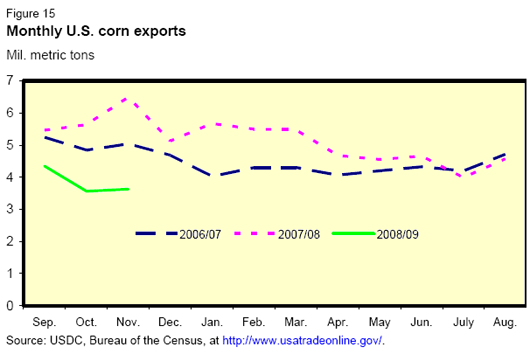

India’s 2008/09 corn export prospects are slashed 0.75 million tons this month to 0.25 million. The price of corn in India is too high to support large exports.
U.S. 2008/09 trade year (October-September) corn exports are projected down 1.0 million tons this month to 45.0 million and down 50 million bushels to 1.75 billion on the local marketing year (September-August). The pace of U.S. sales and shipments of corn have been more like those of 2004/05 than any of the last 3 years. U.S. corn trade year exports in 2008/09 are forecast down 26 percent and from those of a year earlier. According to Census data, during October and November 2008 corn, exports were 7.2 million tons, down 41 percent from exports during those months a year ago. Export inspections of corn in December 2008 were 3.3 million tons, down 34 percent from those during the same period in 2007. As of January 1st 2009, corn outstanding sales were 7.7 million tons, down from 18.5 million a year earlier. With prospects for larger U.S. stocks, there is less incentive this year for importers to purchase ahead for deferred delivery in order to be sure of their corn supply.
Further Reading
| - | You can view the full report by clicking here. |
January 2009








